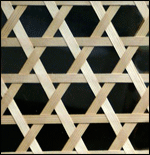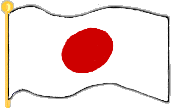かごめ かごめ (籠目籠目)
"Kagome (かごめ) refers to a woven bamboo pattern (in the shape of hexagonal latticework)." -Sadao
The lyrics to this song are considered to be cryptic, and perhaps encouraged by the song's haunting melody, many interpretations have been made about them.
Some think "the bird in the cage" in line two refers to the child in the center of the circle.

かごめ かごめ (籠目籠目)
Kagome, Kagome
Circle Game
Circle Game
(Japanese)
(English)
かごめ かごめ
籠の中の鳥は
いついつ出やる
夜明けの晩に
鶴と亀が滑った
後ろの正面だあれ?
Kagome, kagome,
The bird* in the cage
When, when will it come out?
In the dark-time before daybreak,
A crane and a tortoise slipped and fell.
Who is right behind my back?
Notes
*Or "chicken"
*****
Pronunciation:
Kagome kagome
Kago-no naka-no tori-wa
Itsu itsu deyaru
Yoake-no ban-ni
Tsuru-to kame-ga subetta
Ushiro-no shomen da-a-re?
*****
Sadao Mazuka wrote from Japan about this song:
Meanings:
かごめ かごめ (かごめ means a woven bamboo pattern or the title of this song)
籠の中の鳥は (The bird [or chicken] in the cage is ---)
いついつ出やる (When, when comes out)
夜明けの晩に (At dark time before the daybreak)
鶴と亀が滑った (Slipped down a crane and a tortoise)
後ろの正面だあれ? (Who is on my right back?)
These words above are all cryptic in meaning. We do not know when, where or who wrote the words. Only the phrase かごめ かごめ (Kagome kagome) is found in some old documents from the Edo-period (around 1800). The other words we can't find in such documents, so the completion of this as a children's song is thought to be after the Meiji Restoration in 1868 (according to a Japanese website).
Such mysterious originality in the lyrics encouraged various popular beliefs. One is that the phrase 'The bird [or chicken] in the cage' means a prostitute sold in the slave trade. Or 'all the words are from Hebrew language' is an opinion by a Japanese historian on Israel. Anyway those popular beliefs don't have any definite proof. They're all fishy stories, I think. So my conclusion is that the translation of the song into English has no real meaning.
I recommend you sing the song using the original Japanese song words as follows:
Kagome kagome
Kagome kagome
Kago-no naka-no tori-wa
Itsu itsu deyaru
Yoake-no ban-ni
Tsuru-to kame-ga subetta
Ushiro-no shomen da-a-re?
Game Instructions
One person is the "oni" (which translates to "demon"). The "oni" is the one who is "It". The "oni" sits in the center of the circle with his eyes covered or blindfolded. The other children join hands and walk in a circle around the "oni" while chanting the song. When the song ends, the "oni" tries to name the person standing directly behind him. If the "oni" answers correctly the child behind him becomes the new "oni". If he was not correct, he stays in the center and the other kids continue to walk and chant and play another round.
Comments
One point about the 5th line "A crane and a tortoise slipped down" is that cranes and tortoises are considered to be auspicious symbols but "slipped" can have a dark connotation involving death. This is the type of line that leads people to believe there are hidden meanings in the song.


Thanks!
Thanks!
Thanks!
Thanks and Acknowledgements
Many thanks to Sadao Mazuka for sharing this song, with the pronunciation, translation, midi and commentary!
Arigato gozaimasu! 

























